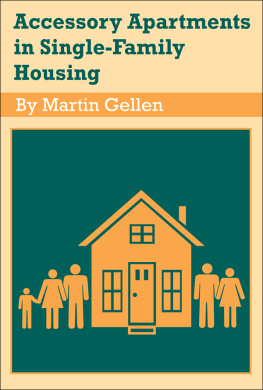
Marketing and Leasing:
APARTMENTS

IREM CONTENT AND
CURRICULUM DEVELOPMENT:
Todd Fiest
Rebecca Niday

2015 by the Institute of Real Estate Management
of the NATIONAL ASSOCIATION OF REALTORS
All rights reserved. Published 2015
Printed in the United States of America
10 Digit: 1-57203-226-X
13 Digit: 978-1-57203-226-2
Ebook ISBN: 978-1-57203-234-7
This book or any part thereof may not be reproduced, stored in a retrieval system, or transmitted, in any form or by any means, electronic, mechanical, photocopying, recording, or otherwise, without the prior written permission of the publisher. Inquiries should be directed to:
Publishing Department
Institute of Real Estate Management
430 North Michigan Avenue
Chicago, IL 606114090.
This publication is designed to provide accurate and authoritative information in regard to the subject matter covered. Forms or other documents included in this book are intended as samples only. Because of changing and varying state and local laws, competent professional advice should be sought prior to the use of any document, form, exhibit, or the like.
This publication is sold with the understanding that the publisher is not engaged in rendering legal, accounting, or any other professional service. If legal advice or other expert assistance is required, the services of a competent professional should be sought.
IREM logo, IREM, CERTIFIED PROPERTY MANAGER, CPM, the CPM key logo, ACCREDITED RESIDENTIAL MANAGER, ARM, the ARM torch logo, ACCREDITED MANAGEMENT ORGANIZATION, AMO, the AMO circle logo, Income/Expense Analysis, Expense Analysis, JPM and MPSA are registered marks of the Institute of Real Estate Management.
Marketing and Leasing:
APARTMENTS

IREM CONTENT AND
CURRICULUM DEVELOPMENT:
Todd Fiest
Rebecca Niday
ACKNOWLEDGEMENTS

We would like to thank the following Review Team for taking time from their personal and professional schedules to provide content and to review this book. Their dedication and support of IREM are greatly appreciated!
REVIEW TEAM MEMBERS
Connie Patterson-Norris, CPM [Gaithersburg, MD]
Tony Pusateri, CPM [Carrolton, TX]
James Edmonds, CPM [Winston-Salem, NC]
Laurel Howell [McLean, VA]
Robert Turnbull [Atlanta, GA]
INTRODUCTION

Marketing and Leasing: Apartments covers how to position your property in the market to attract and retain new residents with key strategies for reaching qualified prospects, selling your propertys benefits, and successfully closing the deal. This includes how to:
- Position your property to succeed in your market
- Showcase your property in the best light to secure new residents
- Achieve higher levels of resident satisfaction and retention by effectively responding to resident issues
Whats covered:
- MARKET ASSESSMENT: Neighborhood analysis, regional demographics, subject property and competition analysis, rent-setting strategies
- MARKETING STRATEGIES: Marketing campaign development, advertising, social media marketing, analytics
- LEASING OFFICE OPTIMIZATION: Communications protocols, legal compliance, online leasing, showing and closing techniques, prospect qualification
- RESIDENT RETENTION: Lease administration, retention strategies, conflict resolution, marketing to existing resident, reputation management
CHAPTER 1:

Multifamily Properties
Property managers must determine how the characteristics and location factors of the multifamily property relate to others in the target market in order to perform a market analysis and derive appropriate rents, and thus achieve the owners goals.
Whats in this chapter:
- Characteristics of multifamily properties
- Specialty residential property types
CHARACTERISTICS OF THE MULTIFAMILY PROPERTY TYPE
To understand how to develop a marketing plan for the multifamily property that will reach its target market, you must be able to identify the characteristics that define a propertys position in the market. See the tables in for a list of property characteristics. Detailed discussion of the topics follows.
Location
Many characteristics define the multifamily market. Of all the characteristics, residents will most heavily scrutinize the propertys location. Location is the primary influence on the desirability of the property.

Q&A: Location
Q: What Defines a Poor Location?
A: Generally, neighborhood issues such as poor access to transportation and employment centers, lower performing schools, and higher crime rates may make profitability at the property a challenge.



Even with skillful management, a property in a poor location will struggle to increase net operating income.

Unit Size, Area, and Layout Details
Next to location, residents consider the unit size, area, and layout in making their housing choice. See the following table for definitions of these features.
Next page


















